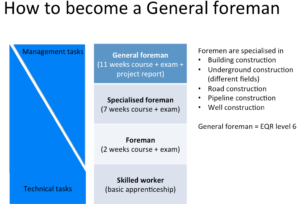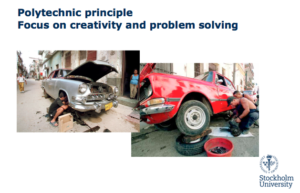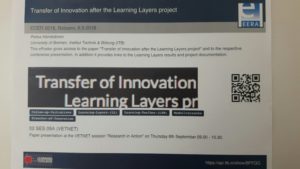The TACCLE4-CPD project is making further progress – Part One: Giving new emphasis on the development of CPD
Last week our EU-funded project TACCLE4-CPD had its third transnational project meeting in Pontypridd, Wales. I have reported on this project in my earlier blogs (December 2017 and June 2018). We are developing frameworks and support for continuing professional development (CPD) of teachers and trainers in promoting their digital competences. As I have told earlier, this project is based on the work of three earlier TACCLE projects that provided direct support for teachers in integrating digital competences to their teaching. This project has the task to develop frameworks, concepts and support resources for CPD measures in different educational sectors (general education, adult education and vocational education and training (VET)). And as I have mentioned elsewhere, the success of all TACCLE projects has been based on the founding work and intellectual leadership of Jenny Hughes. In this respect our meeting was located to Pontypridd to meet Jenny at her home grounds and to make contacts with her local counterparts. Sadly, we lost Jenny shortly before the meeting. In the new situation we had to make a new situation assessment plan our work without counting on Jenny’s active support. Below I try to summarise some key points in our general discussion on the main Intellectual Outputs of the project. In my next blog I will discuss my contributions to the project and how they are related to this discussion.
What does ‘developing CPD’ mean for the project?
To be sure, we had discussed already in the first meetings the aims of our project and the background from where the project idea arises. Yet, at this meeting we had a special need to revisit these discussions. And here we were partly guided by Jenny’s legacy. In an earlier video interview she had told of the time lag between the proposal for the TACCLE1 project (for supporting the development of e-learning content for classroom teaching) and the actual start of the project. During that period the introduction of Web 2.o tools had taken off massively and the project had to catch up with this development. According to jenny, this was managed and the project integrated introduction to Web 2.0 tools into its original idea.
In our project meeting we found ourselves facing a similar challenge. Initially the TACCLE4-CPD project had been planned to scale up the work of the TACCLE courses and related local and regional teacher training activities. Whilst some sections of the proposal were referring to policies, strategies and management choices, other parts were very close to planning specific training activities and support materials for classroom teachers. However, the key idea was to proceed one level up in making transparent the policy choices for shaping training programmes, providing organisational learning opportunities and for linking them to progression models. And as we now saw, it several international organisations were active in mapping this landscape, developing new frameworks and in promoting pilot activities. These newer developments provided us a challenge in keeping up with the discussion and linking our work to it. Below, the implications for two Intellectual Outputs are discussed in this respect.
Implications for our work with Policy Analyses, Route Maps, Frameworks etc.
Concerning policy analyses we were aware of the problem faced by many European projects when they had provided national reports presenting the education and training policies of their countries. Although the aim of these reports had been to inform each other and to faclitate mutual learning, they often highlighted systemic differences and strengthened cultural barriers. From this point of view it was important to get insights into new patterns of sharing policy concepts and adapting policies that had been trialled in other countries (as Graham Attwell reported on the work of Unesco with a group of East-African countries. Also, for our common understanding of ‘policy learning’ it was important to share information on the European DigCompEdu framework that promotes new kinds of developments across different systemic frameworks.
In the light of the above we could give a new emphasis on the work with an integratibe mindmap that Koen de Pryck had started. Instead of separating different countries, we were able to create an overview on policies for promoting digital competences at different levels:
- international policies (impulses and support),
- policies for different (general) educational sectors – primary, lower & upper secondary education, (higher education) and adult education (as educational policies promoting lifelong learning)
- policies for VET (as an insitutional interface between education/training and working life) and to
- specific policies for promoting competences of teachers and trainers (with emphasis on digital competences).
In this context the specific ‘Routemap’ and ‘EMM-framework’ concepts that we had discussed earlier, could be seen as part of a wider group picture and could be linked to other elements. Thus, we could see the seemingly separate tasks as mutually complementing elements within an integrative framework. Also, we could see that the Mindmap could guide different users to find their levels of activity, perceive the dependencies and chances as well as address questions and outline options.
Implications for our work with Open Educational Resources
In a similar way we revisited the question, how to create collections of Open Educational Resources for TACCLE4-CPD. In the earlier TACCLE projects it was clear that the OER collections should equip teachers with teaching materials and pedagogic advice for their work. To some extent this emphasis was present in the proposal. However, as a consequence of the newer developments at different policy levels – and due to newer approaches to ‘policy learning’ – there is a demand for OER collections that cover different levels and address strategic dependencies and/or opportunities for pioneering. From this perspective we concluded that the work with the Mindmap is also the core structure for shaping a collection of OER (with sufficient amount of commentary).
…
I think I have grasped above the crucial steps in revisiting the proposal and reworking our way further. Based on these new perspectives we could see, how many elements of our work were growing together. Also, this discussion helped us to see, how to link input and influences from earlier or parallel projects to our work. In that sense I could see more clearly the importance of the work with the Learning Layers project and its follow-up measures. I will discuss this in my next post.
More blogs to come …
















